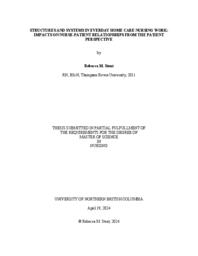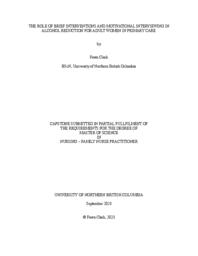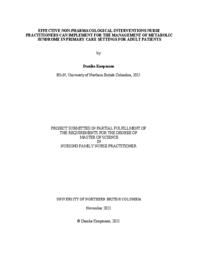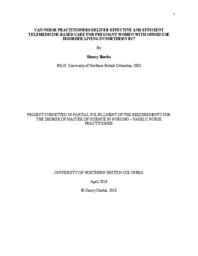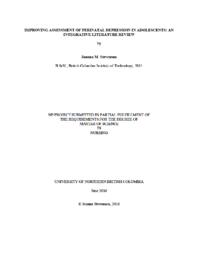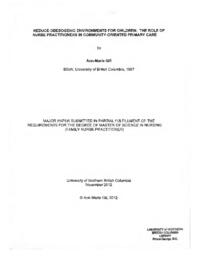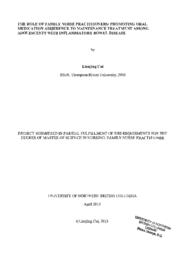Wilson, Erin
Person Preferred Name
Erin Wilson
Related Works
Content type
Digital Document
Description / Synopsis
This thesis examines the institutional structures and systems that coordinate everyday home care nursing work, and how they impact development of nurse-patient relationships from the perspective of patients. Using an institutional ethnographic methodology and incorporating patient-oriented research approaches, I interviewed patients and caregivers to gather rich descriptions of what actually happens in the day-to-day work of receiving home care nursing services, including the work of home care nurses that is visible to patients. Though institutional constraints related to efficiency and productivity can make providing relational care challenging, patients and home care nurses work around these ruling relations and find ways to meet the relational care needs of patients. The often-invisible labour of relational care needs to be recognized and valued at an institutional level to ensure home care nurses can meet the holistic care needs of patients and provide high quality, personalized, patient-centred care within a resource-constrained system.
Origin Information
Content type
Digital Document
Description / Synopsis
Alcohol use is a widely accepted part of Canadian society, however the prevalence of use among Canadian women is increasing. Evidence supports that long-term alcohol related risk and harms escalate more dramatically and at lower doses than that of men, yet research is limited on appropriate interventions for adult women not otherwise captured within obstetric care. Although adult women are frequent users of primary care, screening, and early intervention for problematic drinking is lacking. The purpose of this integrative review is to appraise the existing evidence to determine the role of brief interventions and motivational interviewing in reducing alcohol consumption for adult women in the primary care setting. Recent guideline updates in Canada’s Guidance on Alcohol and Health (Paradis, 2023) to reduce health impacts of alcohol on women, as well as the sex and gender related factors that contribute to health effects of alcohol on women demonstrate the importance of prevention and early intervention. Brief interventions and motivational interviewing have shown limited effectiveness for improving awareness of health effects of alcohol on women and reducing alcohol intake in a patient centered care model. Further research is recommended to improve the quality of evidence and generalizability of practice standards of alcohol use health care related to adult women for primary care providers such as nurse practitioners, family physicians and other allied health professionals.
Origin Information
Content type
Digital Document
Description / Synopsis
Opioid use disorder has become an epidemic over the past 20 years. Contamination of the street sourced drug supply with fentanyl and fentanyl analogues has resulted in a substantial increase in the associated overdose rate. Evidence-based treatments exist; however, much of the evidence supporting their use is based on demonstrations of mortality benefit, abstinence rates, treatment retention and cravings reductions. While these are important outcomes, they do not provide a complete picture of the benefit patients derive from these outcomes. As novel approaches and therapeutic agents are brought into practice, a more thorough understanding of the beneficial outcomes derived from existing therapies is needed both to guide implementation and improve access to therapy. Using the methodology of an integrative review this paper seeks to answer the question: beyond mortality benefit, treatment retention, craving reduction, and abstinence, what beneficial outcomes do people experiencing opioid use disorder derive from opioid agonist therapy? The findings of this review, while limited by the both the quantity and quality of evidence found, suggest that beneficial outcomes of opioid agonist therapy include improved mental and physical health, increased economic participation, reduced criminal activity, and improved quality of life. Associated recommendations for integrating the findings into clinical practice, policy, and research are discussed.
Origin Information
Content type
Digital Document
Description / Synopsis
Bipolar disorder (BD) has significant individual and family consequences and is consistently managed in the family practice setting when there is a lack of specialty services. Family appears to be an underutilized resource and yet is consistently mentioned in current guidelines. This literature review was conducted to determine how family can be incorporated into the family practice setting to improve patient outcomes. A list of recommendations was developed to provide evidence-based rationale to primary care providers to integrate family into the psychosocial management. In doing so, this provides additional resources that are consistent with current recommendations and can support patients with BD.
Origin Information
Content type
Digital Document
Description / Synopsis
Metabolic syndrome consists of a combination of abdominal obesity, dyslipidemia, hypertension, and elevated glucose levels. Metabolic syndrome is prevalent in North America with upwards of 20% of adults meeting criteria for the condition. It is associated with increased risk of morbidity and mortality, particularly cardiovascular disease, stroke, and renal failure. Its prevalence and widespread consequences have major implications for overall burden of disease and cost on the health care system. First-line treatments for management of metabolic syndrome and its associated individual components require a multifaceted approach including nonpharmacological therapy. This integrative review seeks to answer the question: “What are effective non-pharmacological interventions nurse practitioners can implement for the management of metabolic syndrome in primary care settings for adult patients?” The Whittemore and Knafl (2005) method was followed to ensure a thorough process to which the findings and conclusion are described. There are few guidelines offering effective means of implementing non-pharmacological management of this disease. This review assesses the literature and identifies 13 articles which address effective non-pharmacological interventions in the management of MetS. These interventions were grouped into four categories including, dietary interventions, exercise interventions, psychological support, and a combined intervention approach. The lengths of intervention varied from 3 months to 5 years. Providers responsible for delivery of the interventions varied and were not limited to nurse practitioners. The outcomes of significance included improved anthropometric and serological measures, as well as improved participant motivation and behaviour change. For optimal outcomes of patients, the management of metabolic syndrome in a primary care setting requires a multifaceted and patient-centred approach.
Origin Information
Content type
Digital Document
Description / Synopsis
Background. Adolescents are losing the opportunity to observe and practice food skills since diets are shifting from home prepared meals made from basic ingredients to a diet comprised of ultra-processed foods, resulting in reduced consumption of minimally processed foods such as fruits and vegetables. Evidence suggests that engaging in food preparation during adolescence is associated with ongoing healthy dietary behaviours and food preparation practices into adulthood, thus developing food preparation skills in adolescence may help better support individuals to make health informed food choices. Food literacy represents the interdependent concepts related to the facets influencing dietary practices. The objective of the current study was to examine the association between food literacy and fruit and vegetable consumption (FVC) among Canadian adolescents. Methods. Guided by the food literacy framework developed by Thomas et al. (2019), a secondary analysis was conducted on the Canadian Community Health Survey, Rapid Response on Food Skills (Part 2) – mechanical skills and food conceptualization. The sample population (N=790) included all survey respondents aged 12- 17 years who responded to the survey questions that built the outcome variable: total daily fruit and vegetable consumption. Results. When compared to respondents who report low levels of food skill, respondents who reported high food skill levels in the ability to cook from basic ingredients (OR 1.84, 95% CI 1.12-3.02), freeze vegetables from raw (OR 1.50, 95% CI 1.00-2.24), and to adjust a recipe to make it healthier (OR 3.02, 95% CI 1.29-3.26) were more likely to consume fruits and vegetables five or more times a day. Respondents who came from households where the highest level of household educational attainment was trades had lower odds of consuming fruits and vegetables five or more times a day compared to households where the highest level of educational attainment was a bachelor’s degree or higher (OR 0.34, 95% CI 0.14-0.81). Within the logistic regression model, significant relationships were found between FVC and a respondent’s sex (p=0.04), perceived eating habits (p<0.001), and highest level of household educational attainment (p=0.02). Discussion. Significant relationships between FVC and food literacy were evident in food skills that were multifaceted, requiring that adolescents have the ability to perform a number of basic food skills and reflective of several food literacy attributes. The relationships found between multifaceted food skills and adolescent FVC suggest that food literacy attributes are interconnected and have reciprocal relationships. Conclusion. Dietary behaviours are influenced by multiple factors. Study findings suggest that higher levels of adolescent food literacy, as reflected in multifaceted food skills, have the potential to positively impact their FVC. However, when societal factors are controlled for, food skills were not found to have a significant relationship with adolescent FVC, suggesting that factors outside of the control of the individual have the potential to minimize the influence of individual food literacy characteristics on adolescent FVC. Future food literacy programs should be inclusive of adolescents from all SES and should aim to teach and evaluate food literacy attributes that build more complex food skills.
Origin Information
Content type
Digital Document
Description / Synopsis
Transitions to long-term care are significant and often challenging experiences for older adults with dementia and their caregivers, with waiting lists a common occurrence due to an aging population and a limited supply of long-term care beds. To better understand the complexities related to transitions to long-term care and inform clinical practice, a comprehensive project was undertaken and included an integrative literature review and a gap analysis of local practices in the interior of British Columbia. The literature review and gap analysis findings were analyzed and presented thematically through interrelated themes, including key concepts surrounding the phases of a transition, caregiver coping, and professional support. Four key recommendations arose from this project regarding continuity and coordination of care, discharge planning, post-discharge care, and evaluation. The strengths, limitations, and implications of this project are discussed, including next steps to mobilize knowledge related to the recommendations and influence evidence-informed changes in practice.
Origin Information
Content type
Digital Document
Origin Information
Content type
Digital Document
Origin Information
Content type
Digital Document
Origin Information
Content type
Digital Document
Origin Information
Content type
Digital Document
Origin Information
Content type
Digital Document
Origin Information
Content type
Digital Document
Origin Information
Content type
Digital Document
Origin Information
Content type
Digital Document
Origin Information
Content type
Digital Document
Origin Information
Content type
Digital Document
Origin Information
Content type
Digital Document
Origin Information
Content type
Digital Document
Origin Information

